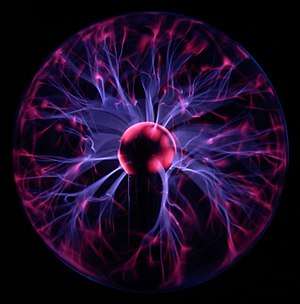Degree of ionization
The degree of ionization (also known as ionization yield in the literature) refers to the proportion of neutral particles, such as those in a gas or aqueous solution, that are ionized to charged particles. For electrolytes, it could be understood as a capacity of acid/base to ionize itself. A low degree of ionization is sometimes called partially ionized (also weakly ionized), and a high degree of ionization as fully ionized. However, fully ionized can also mean that an ion has no electrons left.[1]

Ionization refers to the process whereby an atom or molecule loses one or several electrons from its atomic orbital, or conversely gains an additional one, from an incoming free electron (electron attachment). In both cases, the atom or molecule is no more a neutral particle and becomes a charge carrier. If the species has lost one or several electrons, it becomes positively charged and is called a positive ion, or cation. On the contrary, if the species has gained one or several additional electrons, it becomes negatively charged and is called a negative ion, or anion. Individual free electrons and ions in a plasma have very short lives typically inferior to the microsecond, as ionization and recombination, excitation and relaxation are collective continuous processes.[2]
Chemistry usage
The degree of dissociation α (also known as degree of ionization), is a way of representing the strength of an acid. It is defined as the ratio of the number of ionized molecules and the number of molecules dissolved in water. It can be represented as a decimal number or as a percentage. One can classify strong acids as those having ionization degrees above 30%, weak acids as those with α below 30%, and the rest as moderate acids, at a specified molar concentration.
Physics usage
In gases, the degree of ionization refers to the proportion of neutral particles that are ionized into charged particles:
where is the ion density and the neutral density (in particles per cubic meter). It is a dimensionless number, most of the time expressed as a percentage.
In a plasma, the electron-ion collision frequency is much greater than the electron-neutral collision frequency . Therefore, with a weak degree of ionization , the electron-ion collision frequency can equal the electron-neutral collision frequency: is the limit separating a plasma from being partially or fully ionized.
The term fully ionized gas introduced by Lyman Spitzer does not mean the degree of ionization is unity, but only that the plasma is in a Coulomb-collision dominated regime, i.e. when , which can correspond to a degree of ionization as low as 0.01%.[2]
A partially or weakly ionized gas means the plasma is not dominated by Coulomb collisions, i.e. when .
Sometimes "fully ionized" means there are no orbital electrons left.[1] A particular case of fully ionizes gases are very hot thermonuclear plasmas, such as plasmas artificially produced in nuclear explosions or naturally formed in our Sun and all stars in the universe. Stars contain largely hydrogen and helium gases, that are fully ionized into electrons, protons (H+) and helium ions (He++). Equations to characterize such very hot, fully ionized thermonuclear plasmas in the presence of stellar magnetic fields can be approximated to ideal magnetohydrodynamics laws with high magnetic Reynolds number.
History
Ionized matter was first identified in a discharge tube (or Crookes tube), and so described by Sir William Crookes in 1879 (he called it "radiant matter").[3] The nature of the Crookes tube "cathode ray" matter was subsequently identified by English physicist Sir J.J. Thomson in 1897,[4] and dubbed "plasma" by Irving Langmuir in 1928,[5] perhaps because it reminded him of a blood plasma.[6]
See also
- List of plasma (physics) articles
Footnotes
- Mochizuki, Y.; Takahashi, K.; Janka, H.-Th.; Hillebrandt, W.; Diehl, R. (2008). "Titanium-44: Its effective decay rate in young supernova remnants, and its abundance in Cas A". Astronomy and Astrophysics. 346 (3): 831–842. arXiv:astro-ph/9904378.
- Chapman, Brian (25 September 1980). Glow Discharge Processes: Sputtering and Plasma Etching. New York: John Wiley & Sons. ISBN 978-0471078289.
- Crookes presented a lecture to the British Association for the Advancement of Science, in Sheffield, on Friday, 22 August 1879
- Announced in his evening lecture to the Royal Institution on Friday, 30 April 1897, and published in Philosophical Magazine, 44, 293
- I. Langmuir, "Oscillations in ionized gases," Proc. Natl. Acad. Sci. U.S., vol. 14, p. 628, 1928
- G. L. Rogoff, Ed., IEEE Transactions on Plasma Science, vol. 19, p. 989, Dec. 1991. See extract at "Archived copy". Archived from the original on 20 April 2006. Retrieved 24 May 2006.CS1 maint: archived copy as title (link)